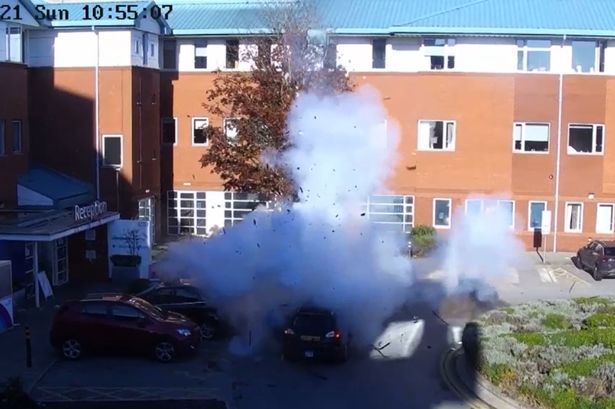The former pizza chef turned vicious terrorist who blew himself up outside Liverpool Women's Hospital was initially planning a very different attack involving home made firearms.
Counter Terrorism Policing North West (CTPNW) provided an update today following the completion of its investigation into the failed attack on the Toxteth maternity hospital – which by astonishing good fortune only took the life of suicide bomber Emad Al Swealmeen.
CCTV footage showed how the would-be mass murderer arrived at the hospital's main entrance at 10.55am in a Delta Taxi driven by David Perry. As the taxi came to a stop it exploded, but Mr Perry was able to stagger free before the vehicle was engulfed in flames.
READ MORE: Live updates as Liverpool Women's Hospital bombing investigation findings released
READ MORE: Liverpool Women's Hospital bomber said he travelled to UK to 'watch Britain's Got Talent'
It quickly became apparent the former pizza chef and warehouse worker had plotted his attack alone in two addresses, one a house of multiple occupation (HMO) in Sutcliffe Street, Kensington, provided by Serco to house asylum seekers. The other was a privately rented flat in Rutland Avenue, near Sefton Park, where he had constructed the bomb as indicated by chemicals, mixing bowls and tools strewn around the place.
The 32-year-old had significant mental health issues which, detectives believe, were exacerbated by his long-running battle to claim asylum in the UK after arriving from Jordan in 2014. Al Swealmeen had been sectioned in February, 2015, after running around with a knife and trying to jump over a motorway fly-over, and tried to take an overdose in August that year.
As counter terror police attempted to pore over his online activity, it became clear Al Swealmeen had used sophisticated encryption software to hide what he was doing. But the investigation team were able to trace a series of transactions and online orders, which revealed how he initially appeared to favour a gun attack.
Today Detective Superintendent Andy Meeks, from CTPNW, outlined what his officers had determined after a complex two year investigation. Speaking of the property in Sutcliffe Street he said: "We conducted a thorough search of that house specifically focused on his bedroom. We found some items concealed under the floorboards which had been wrapped in newspaper and polythene.
"We established the newspaper used to wrap the items post-dated October 2019 which was when Al-Swealmeen moved into the flat. So we therefore knew he was likely responsible. That was confirmed by later linking him forensically to those items.
"The packages consisted of two, and this is based on the expert assessment, two unfinished improvised firearms, 11 magazine clips in 9mm and .45 calibre, over 90 9mm and .45 calibre dummy cartridges, a cartridge loading device and an improvised silencer. We also found evidence of experimentation with ammunition, we believe this has been attempts by him to re-purpose inert ammunition."
DS Meeks said there was no evidence available that Al Swealmeen had sought advice from other criminals on how to build a bomb, but an image was found on his phone of the screen of another device, containing partial instructions. DS Meeks said there was no evidence to say where he had obtained those instructions.
He said: "There are two distinct periods of online purchase activity which provide an understanding of Al Swealmeen's changing aspirations between March 2020 and November 2021.
"Between March and July 2020, Al Swealmeen's efforts were focused on the acquisition of tools and materials to manufacture improvised firearms and ammunition. He initially purchased quantities of inert ammunition which he had delivered to the Sutcliffe Street address. These were followed by the purchase of metal box section piping, welding equipment, assorted tools, chemicals to make gunpowder and soundproofing material.
"Al Swealmeen did take some steps to conceal his identity and used the alias 'Wade McCloud' as his online name, creating linked email addresses in support of his false identity.
"From August 7, 2020, Al Swealmeen's attention clearly shifted to the acquisition of materials to manufacture an improvised explosive device (IED).
"In addition to quantities of chemicals, Al Swealmeen, also purchased other items for use in the assembly of the IED including filter papers, chemistry flasks and electrical circuitry and testing equipment. The final online purchase made on 1st November 2021 was for a large quantity of steelball bearings. These were not delivered until 10th November, just four days before the attack."
Merseyside Police Assistant Chief Constable, Jon Roy, also spoke at the briefing and described the reaction of the public to the astonishing events of that day, particularly staff at Liverpool Women's Hospital.
He said: "The reaction of the public was unbelievable; in the face of adversity they were strong and determined and unbowed. Ultimately the aim of terrorists is to create conflict, distrust and fear, but that didn’t happen here and people across Liverpool stood shoulder to shoulder.
"And the tenacity and strength of the management, staff and patients at Liverpool Womens’ Hospital was outstanding."
Merseyside Police and Crime Commissioner Emily Spurrell added: "Whilst a precise motive for the attack remains unclear, it is important we try to understand what influenced him to carry out his cowardly deed to better prepare for and deter any attempts to cause mass devastation in the future.
"Today’s report raises more concerns around the effectiveness of our asylum system, the way claims are processed, support available to asylum seekers and what procedures are used to monitor those individuals who are refused permission to live in the UK.
"These incidents are thankfully very rare, and I want to reassure our communities that Merseyside Police and Counter Terrorism North-West work around the clock, with all partner agencies to prevent them from happening."

